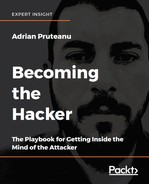This chapter showcased a number of tools and techniques that work together to make an otherwise-tedious part of the engagement seamless. Burp Suite, or the free alternative OWASP ZAP, both provide ways to extend functionality and make quick work of repetitive tasks.
We've also looked at an easy way to obfuscate code that may end up on a target system. When dropping a custom shell on a server, it's a good idea to hide its true function. A passing blue teamer may not look twice if the code looks overly complex. We've used tools to quickly transform our generated backdoor into a less conspicuous output.
Finally, building on the previous chapter's out-of-band vulnerability discovery techniques, we leveraged Burp's Collaborator server to streamline the whole process. Collaborator is an indispensable tool and, if possible, should always be enabled when attacking web applications. In the next chapter, we will switch gears and look at exploiting an interesting class of vulnerabilities related to object serialization.
In the next chapter, we will switch gears and look at an increasingly common vulnerability type, which could be devastating if exploited successfully. Deserialization attacks are here to stay and we will dig a bit deeper into how they work and how to exploit them.
